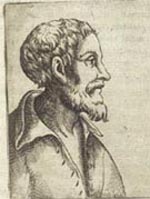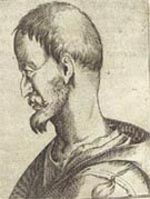
The History of Physiognomy
A Leverhulme Trust International Network
Queen Mary University of London (London), Ecole Normale Supérieure (Paris), and Scuola Normale Superiore (Pisa)

 |
The History of PhysiognomyA Leverhulme Trust International NetworkQueen Mary University of London (London), Ecole Normale Supérieure (Paris), and Scuola Normale Superiore (Pisa) |
 |
|
HomeAbout the NetworkAbout PhysiognomyContactMembersParticipantsEventsBibliographyResources/Links |
Shearer West (University of Birmingham and Arts and Humanities Research Council)'Portraiture, Caricature, Eccentricity' Although scholars generally interpret caricature as a personalised form of visual satire, both artists and writers in the late Georgian period saw caricature and portraiture as generically related. Lavater's Essays on Physiognomy argued that many works of art that were called portraits were actually caricatures, because they distorted the truth, rather than embodying it. This distortion could take the form of grotesquerie or idealisation, but neither, according to Lavater, had the fidelity to the original that portraiture required. This idea was echoed by William Hazlitt, whose 'Imitation of Nature' of 1814 labelled grand manner portraits as 'merely caricature transposed; that is, as the caricaturist makes a mouth wider than it really is, so the painter of flattering likeness (as they are termed) makes it not so wide, by a process just as mechanical, and more insipid.' Within the Royal Academy, the painter John Opie called portraiture 'a more respectable kind of caricature'. The problem for portraiture was that deformity, in eighteenth-century parlance (that is, irregularity or ugliness), was theoretically outside the realm of the portraitist's art. If a portraitist was aiming to, at best, 'raise the lower by borrowing from the grand', and at worst, flatter a demanding sitter, deformity of any sort was proscribed. However, there were instances in which the modes of portraiture and caricature moved closer together. This paper considers the relationships between portraiture, caricature and a fascination with eccentric characters at the end of the eighteenth century that was fuelled by Lavater's theological argument for individuality and human distinctiveness. While appearing in metaphysical poetry of the seventeenth-century in reference to individuals, 'eccentric' at that time retained connotations of Ptolemaic astronomy--of planets out of line with the orbit of the earth--or geometry-- of circles without a common centre. However, by the 1780s and 1790s, 'eccentric' had lost these associations and began to replace the concept of 'singularity' in referring to oddity or whimsicality. However, unlike the modern psychological usage of the word, eccentricity in this period had a very wide and sometimes indiscriminate set of connotations, referring to anomaly or difference in all its forms--both behavioural and physical. How eccentricity could be visualised through the body was a concern for portraitists and caricaturists that fed on the preoccupations of Lavater himself. This paper will examine Lavater's view of the human face in the light of the growing fashion for eccentric compendia, in which portraits and biographies of outré individuals were published and collected.
'L'art du portrait, la caricature, l'excentricité' Bien que les spécialistes interprétent la caricature comme une forme personalisée de satire visuelle, les artistes et les écrivains de la fin de l'époque Géorgienne percevaient la caricature et l'art du portrait comme des expressions de types génériques. L'Art de connaître les hommes par la physiognomonie de Lavater soutient que beaucoup de portraits étaient en fait des caricatures parce qu'ils déformaient la vérité au lieu de l'incarner. Cette déformation pouvait prendre la forme du grotesque ou de l'idéal, mais ni l'une ni l'autre, d'après Lavater, n'était suffisamment fidèle à l'original pour l'art du portrait. Cette idée fût aussi exprimée par William Hazlitt, dont l' Imitation of Nature de 1814 présentait les 'grand manner' portraits comme 'merely caricature transposed; that is, as the caricaturist makes a mouth wider than it really is, so the painter of flattering likeness (as they are termed) makes it not so wide, by a process just as mechanical, and more insipid.' Au sein de la Royal Academy, le peintre John Opie appellait l'art du portrait 'a more respectable kind of caricature'. Le problème pour l'art du portrait était que la difformité, dans la langue du dix-huitième (irrégularité et laideur), était théoriquement hors du domaine de l'art du portraitiste. Soit qu'un portraitiste tentait, au mieux, de 'raise the lower by borrowing from the grand', ou au pire, de flatter un modèle exigeant, la difformité sous toute ses formes était proscrite. Pourtant, il y avait des moments où les modes de l'art du portrait et de la caricature se rapprochaient l'un de l'autre. Cette communication considère les relations entre l'art du portrait, la caricature et une fascination pour les caractères excentriques à la fin du dix-huitième siècle qui furent encouragés par l'argument théologique de Lavater sur l'individualité et la particularité de l'humain. Bien qu'elle apparaisse dans la poésie métaphysique du dix-septième en référence aux individus, la notion d'excentricité en ce temps là avait toujours des connotations liées à l'astronomie Ptolémaïque - des planètes hors des lignes de l'orbite terrestre - ou à la géométrie - des cercles sans un centre commun. Pourtant, à partir des années 1780's et 1790's, l'excentricité perd ces connotations and commence à remplacer le concept de 'singularité' pour désigner l'étrange et le saugrenu. Mais, contrairement à l'utilisation de ce mot en psychologie moderne, l'excentricité à cette période avait un large éventail, parfois sans distinction, de connotations - autant comportementales que physiques. Comment visualiser l'excentricité à travers le corps ? Ceci fût une des préoccupations des portraitistes et caricaturistes qui se nourrit de celles de Lavater. Cette présentation examinera les vues de Lavater sur le visage humain à la lumière de l'engouement grandissant pour les 'collections' de l'excentrique dans lesquels les portraits et les biographies d'individus outrés étaient publiés et collectionnés.
Go back to Physiognomy from Della Porta to Lavater
|
|||||